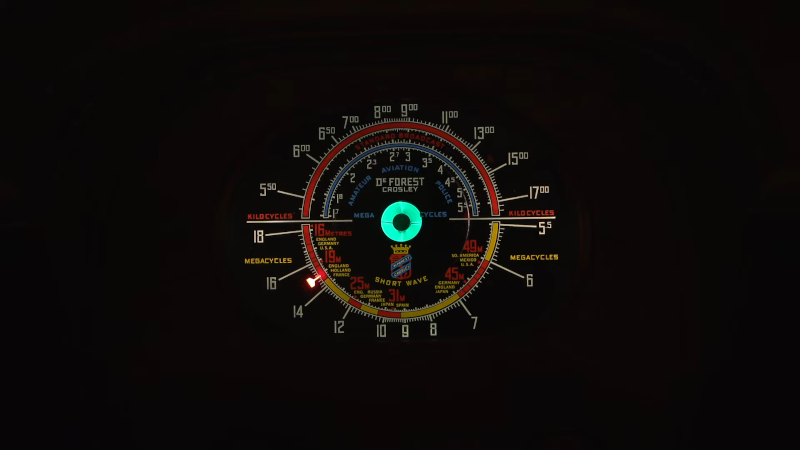[Mr. Carlson] is truly an old radio surgeon. The evidence? He recently restored an 83-year-old DeForest radio by transplanting an identical chassis from another similar radio. The restoration is fun to watch, but the 7D832 radio dial looks amazing. The dial is very colorful and the wooden knobs and preset selector are beautiful. To seal the deal, the center of the dial has a magic eye tube, giving the radio a retro high tech look.
The donor chassis needed some work before the surgery. In addition, [Carlson] makes some improvements along the way. The radio showed signs of previous service work, which is not surprising after 83 years.
The preset dial is interesting and required two adjustments in the back of the radio. Each button had a limited range of frequencies. We suspect this was a pretty high-end radio in its day.
There are some interesting tubes in the radio including Canadian tubes with a metal spray-on shield. We will warn you: the video is about three and a half hours long. No kidding. There’s a lot to talk about. We know its a big investment of time, but if you are interested in old radios, there’s a lot here and a great opportunity to watch a pro restore a radio from start to finish.
We love the look and sound of these old radios. We’ll admit, not all of them are as pretty as this DeForest.
















That is a beautiful radio!
Kind of reminds of a car speedometer.
Finally, no Atmega! Well done.
When I was a kid, we would spent spend weekends at our family hunting cabin, and one of the cool things there was a working Zenith console shortwave radios with the classic dial similar to the DeForest. One of the interesting thing of radios of that era was various broadcasters were so well established that the “names” were on the dial.
I have a working tube radio from the early 1960s. The AM and short wave scales have the names (locations) of many radio stations permanently marked. Of the ones still operating, they are still at the frequency marked on the scale 60 years ago.
Here in the UK, back in the late 60s the BBC renamed their three radio stations from Home, Light and Third, which were printed on most radio dials, to Radio 4, Radio 2 and Radio 3, and introduced the imaginatively-named Radio 1, and jiggled the frequencies around a bit too. I was only 3 or 4 at the time but I remember tiny silver-coloured diamond-shaped stickers with 1, 2, 3 and 4 printed on that you stuck on your radio dial to correct it for the new names and frequencies.
I like it how the dial reads “kilocycles” and “megacycles”. :)
i did one a couple years ago. these restorations can be a simple or as intricate as you want.
https://imgur.com/a/UbJ5bk9
Such a beautiful piece of work, that dial! How was it manufactured? Screen printing on the glass?
Wow! Amazing.
I never finished a project where I collected images of a bunch of old radio dials and put a 5″ screen in a walnut housing with bluetooth audio – sort of a re-visioning of those retro radios (though mine wasn’t tombstone since I never liked that design). One of the controls (rotary encoder) would allow you to flip through which display you wanted the screen to show. Of course the display was static, but from a distance it looked really good.
The problem was it sounded like crap. All good radios these days use DSP to do audio shaping, and that’s not a skill I have.
This dial is one of the ones I had in the selection.
AM can really sound good if you are careful with bandwidth, filter phase linearity, etc. It doesn’t have the high frequencies but when designed properly an AM receiver is pretty listenable. Most radios today have significant compromises and sound like old wired telephones.
Any radium in that dial?
No radium. Its all back lit…
Classy radio. Very appealing compared to the ‘plastic’ stuff we have today.
Lots of work to get it back into shape. Amazing tenacity to keep at it and get ‘er done :) .
Glad to see the respect and value for antique radios.
Some of these radios didn’t only have callsign labels but network names, i.e., Red and Blue.
There was the sense of leading edge technology when this was made and no assurance it would be stable and used in the future.
Radio was a special thing at the time with only about 700 stations in the US compared to about 15,000 today.
I’m so amazed that the way streets and cities were laid out in the 1800’s are still efficiently useful today with cars and trucks, water sewer and gas/electricity utilities etc., which weren’t even contemplated when the cities were built.
I also have a deep imagination when I listen to a radio that was manufactured in the 1930’s that receives modern radio stations broadcasting as ongoing businesses in hometowns with current listeners and commercial support.
The FCC is trying to change this up (https://docs.fcc.gov/public/attachments/FCC-20-154A1.pdf).
I hope it doesn’t catch on.
TMFL/DW, but I did skip through some quick looks, really amazing job and I’m glad to see that after this restoration this radio will last in good shape for at least a century.
Question will be, will there still be AM stations in 100years, even 50years? Thought you can use your own low power transmitter to transmit audio to these. Mr Carlson does infact do that with his radios. A few of his videos he has mentioned using low power transmitters to transmit xmas songs to them during the holidays.
I like the “emergency hair repair” in the first hour.
You’ve got to keep your priorities straight. :)